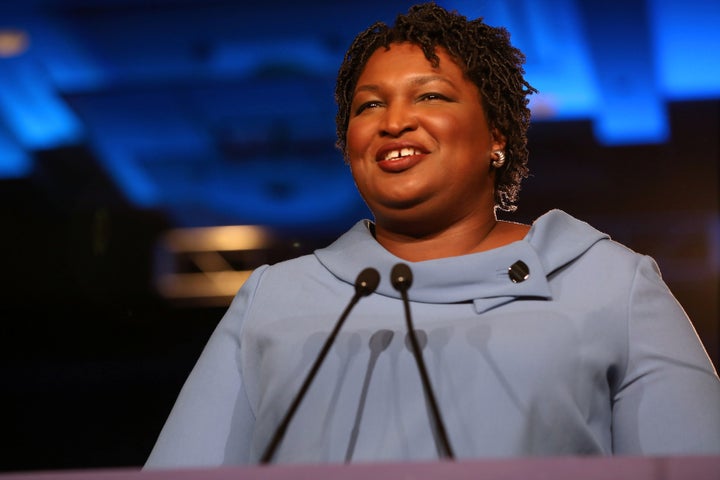The Democratic Party’s picks to give responses to President Donald Trump’s first two addresses to Congress reflected the state of uncertainty the party found itself in. After giving the 2017 slot to then-72-year-old former Kentucky Gov. Steve Beshear — a backward-looking pick if there ever was one — they followed up with the selection of Massachusetts Rep. Joe Kennedy, best known for being the scion of the quintessential Democratic family.

Both speeches had their merits — Beshear’s, in particular, previewed the party’s relentless focus on health care during the midterm elections — but are mostly now remembered for the awkwardly lit diner where Beshear delivered his speech and for how wet Kennedy’s lips appeared.
Former Georgia gubernatorial candidate Stacey Abrams’ speech this year may also end up being remembered for something other than its content, if it’s remembered at all. (It has been years since the State of the Union — or the opposition party’s response — had an actual, measurable impact on American politics.) But Democratic leaders’ decision to have Abrams deliver the response shows the party isn’t quite as lost as it was in the months following Trump’s surprising victory over Hillary Clinton. The party, or at least its top operatives, now knows in what direction it wants to head, and it’s toward more candidates like Abrams.
Many Democrats now view Abrams’ campaign, which came up just short against Brian Kemp, a Trump acolyte, as a model for future candidates. The party, which spent much of 2017 and 2018 caught in a debate about whether it should focus on mobilizing young people and voters of color or winning over suburban voters who are disenchanted with Trump, views Abrams as proof it doesn’t need to be a choice.
Abrams, as a black woman who spent years courting donors to fund voter registration projects targeting people of color through her New Georgia Project, is often given the shorthand label of a progressive. But her 2018 campaign showed just as much dedication to reaching out to the middle as it did to firing up her party’s base.
As early as her primary against Stacey Evans, Abrams positioned herself as a candidate who could appeal across Georgia’s racial and urban-suburban-rural divides. In a 30-second ad titled “Guys Like Me,” a white union worker, speaking with a slight drawl, delivers his pitch for Abrams.
“She understands all of Georgia,” says Kenny Mullins, an official with a local International Brotherhood of Electrical Workers chapter. “She’s fighting against tax hikes that are going to hurt guys like me that get up at the crack of dawn to go and work long hours.”
Throughout the campaign, she continued reaching out to business groups and Republicans. In another spot, released in October, the Georgia Democratic Party noted she worked with the GOP and fought to stop “a massive tax hike on Georgians.”
“We can continue the progress we’ve made by building each other up, not tearing each other down,” Abrams says in the ad.
And none of her outreach to the center took away from her work to register and turn out minority and young voters who were more likely to support Democrats. At the same time, she largely avoided embracing left-wing policy priorities like “Medicare for all” and abolishing Immigration and Customs Enforcement.
“Her message was very open to everyone,” said Washington Gov. Jay Inslee, who chaired the Democratic Governors Association during Abrams’ run and funneled about $4.5 million to support her. “It was about economic opportunity. It wasn’t exotic or avant-garde.”
The result was sky-high turnout and a narrow loss in a state where Democrats had become accustomed to even highly sought-after recruits losing by substantial margins. (And Abrams’ result must be considered in light of Kemp’s influence as Georgia’s secretary of state on the election process. She has said that the election was “not free and fair” and that he enabled “the systemic dismantling of our democracy.”)
Her message went furthest in the state’s suburbs: According to The Atlanta Journal-Constitution, she won Cobb County, a populous suburb of Atlanta where former House Speaker Newt Gingrich began his political career, with 54 percent of the vote, four years after GOP then-Gov. Nathan Deal won it with 56 percent. In Gwinnett County, she garnered 57 percent of the vote, a massive spike from the 42 percent Democratic nominee Jason Carter got in the 2014 governor’s contest.
“Her message was very open to everyone. It was about economic opportunity. It wasn’t exotic or avant-garde.”
- Washington Gov. Jay Inslee, former chairman, Democratic Governors Association
Abrams’ bipartisan tendencies, which date back to her time in the state legislature, have long generated suspicion among some progressives, even as journalists have often painted her as part of the party’s left wing. But Abrams surpassed expectations in a way that Democratic candidates who ran more left-leaning campaigns — like Florida’s Andrew Gillum, Arizona’s David Garcia and Maryland’s Ben Jealous — weren’t able to.
Of course, her strategy isn’t easily replicated. Jealous and Garcia were hammered by millions of dollars in attack ads from the Republican Governors Association, leaving them with little chance of success. But Abrams, a favorite of both the Democratic small-dollar donor base and the party’s megadonors, had more than enough cash to invest in getting her message out, parrying GOP attacks and getting out her core voters.
Abrams wasn’t alone in this type of success. Other Democrats have pointed to Sen. Kyrsten Sinema, a more conservative Democrat, who used a similar strategy of investing big dollars in field and digital operations to turn out younger and more progressive voters while using television ads to reach across the aisle with messages focused on helping veterans and protecting Obamacare.
And now New York Sen. Chuck Schumer hopes he can persuade Abrams to join Sinema in Congress’ upper chamber. Schumer and Nevada Sen. Catherine Cortez Masto have met with Abrams, hoping to get her to challenge GOP Sen. David Perdue, a Trump favorite and former CEO who is running for a second term in 2020.
The ambitious Abrams, who famously used an Excel spreadsheet to plan out her life ― including a 2028 presidential run ― has always wanted to be governor of Georgia but isn’t ruling out a Senate bid. Her team is in nearly constant contact with EMILY’s List, which heavily backed her 2018 run. She has launched Fair Fight Georgia, a group that she said will “will pursue accountability in Georgia’s elections and integrity in the process of maintaining our voting rolls.” The group has already filed a major lawsuit against the state and aired a Super Bowl ad focused on voter rights.
Republicans, meanwhile, are acting as if she’s already a candidate. The Senate Leadership Fund, a super PAC run by allies of Senate Majority Leader Mitch McConnell, has sent out press releases calling Fair Fight a “political slush fund.” And the National Republican Senatorial Committee released a video attacking her before her State of the Union response.
But maybe Abrams is aiming a little higher. Fair Fight Georgia is hosting watch parties for her response, including a dozen in Georgia. It’s also hosting some in other states ― including in South Carolina, Iowa and New Hampshire. 2028 isn’t that far away.

